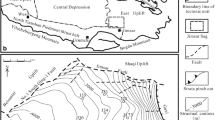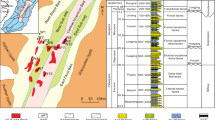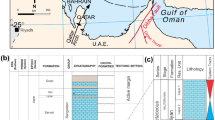Abstract
Groundwater storage in an atoll that is facing water shortage is a crucial issue for freshwater supply and agricultural practices. As a solution to increase the volume of freshwater in an atoll, a floating-type underground dam is proposed. Precipitation, which displaces brine in underground reservoirs, is stored as a freshwater resource in the underground dam. However, the aquifer in an atoll consists of vuggy limestone, such as Ryukyu limestone, which possesses a wide range of pore sizes and heterogeneous pore structure such that the retardation of salinity reduction in the aquifer is of concern when considering freshwater reservoirs. To understand the pore structure of such vuggy limestone, X-ray computed tomography scans were conducted for eighteen cylindrical Ryukyu limestone cores 100, 50, and 6 mm in diameter. Cluster analysis of the three-dimensional distributions of the pores revealed that the Quaternary vuggy Ryukyu limestone has a binary fractal with a wide size distribution of at least 12 orders for the pore volume and 10 orders for the pore surface area. To model the Ryukyu limestone numerically, a simplified method for pore structure modeling is required. Our numerical approach suggests that the three-dimensional pore structure of Ryukyu limestone aquifer can be modeled using a binary fractal aggregation of spheres of various sizes.















Similar content being viewed by others
Abbreviations
- y :
-
The logarithm of \(N\).
- N :
-
The number of pore clusters with attributes that are larger than \(V\) or \(S\).
- N b :
-
The number of pore clusters with attributes that are larger than \(V\) or \(S\) in one cubic meter.
- \(\overline{y}\) :
-
The arithmetical mean of \(y\).
- i :
-
An integer used to indicate the section with the largest volume/surface area.
- m :
-
The number of sections used to determine \(V\) or \(S\).
- f :
-
The logarithm of the number of pore clusters predicted by the fitted line in the measured plots \((f = a + b\log x)\).
- a :
-
Constant.
- b :
-
Constant.
- x :
-
The volume (\(V\)) or surface area (\(S\)) of a pore cluster.
- R 2 :
-
Coefficient of determination for the fitted line.
- \(\overline{{V_{j} }}\) :
-
The volume of a small sphere used to calculate the surface area of a simplified pore.
- V j :
-
The volume for interval classification used in the frequency distribution of the volume of the pore clusters.
- V min :
-
The smallest volume for interval classification used in the frequency distribution of the volume of the pore clusters.
- α :
-
An arbitrary number representing shape complexity extent of a pore cluster against the sphere
- Nss :
-
The number of the small spheres among a reference pore volume.
- S sp :
-
The surface area of the simplified pore.
- S r :
-
The surface area of the small reference spheres
References
Anovitz LM, Cole DR (2015) Characterization and analysis of porosity and pore structures. Rev Mineral Geochem 4(80):61–164. https://doi.org/10.2138/rmg.2015.80.04
Bailey TR, Jenson JW, Olsen AE (2010) Estimating ground water resources of atoll islands. Water 2:1–27. https://doi.org/10.3390/w2010001
Bailey TR, Khalil A, Chatikavanij V (2014) Estimating transient freshwater lens dynamics for atoll islands of the Maldives. J Hydrol 515:247–256. https://doi.org/10.1016/j.jhydrol.2014.04.060
Blunt JM, Bijeljic B, Dong H, Gharbi O, Iglauer S, Mostaghimi P, Paluszny A, Pentland C (2013) Pore-scale imaging and modelling. Adv Water Resour 51:197–216. https://doi.org/10.1016/j.advwatres.2012.03.003
Buades A, Coll B, Morel JM (2005) A non-local algorithm for image denoising CVPR 2005. IEEE Comp Soc Conf Comp Vis Patt Recognit. https://doi.org/10.1109/CVPR.2005.38
Buades A, Coll B, Morel JM (2008) Nonlocal image and movie denoising. Int J Comput Vision 76(2):123–139. https://doi.org/10.1007/s11263-007-0052-1
Dong H, Blunt MJ (2009) Pore-network extraction from micro-computerized-tomography images. Phys Rev E 80:036307. https://doi.org/10.1103/PhysRevE.80.036307
Furukawa H, Kuroda T (2011) The underground dam: a new concept in water resource development to meet the challenges of natural disaster and climate change, Kaichosha. ISBN: 9784874158241
Gischler E (2007) Pleistocene facies of Belize barrier and atoll reefs. Facies 53:27–41. https://doi.org/10.1007/s10347-006-0086-9
Hidajat I, Mohanty KK, Flaum M, Hirasaki G (2004) Study of vuggy carbonates using NMR and X-ray CT scanning. SPE Res Eval Eng 7:05. https://doi.org/10.2118/88995-PA
Ikeda S, Nakano T, Nakashima Y (2000) Three-dimensional study on the interconnection and shape of crystals in a graphic granite by X-ray CT and image analysis. Mineral Mag 64(5):945–959. https://doi.org/10.1180/002646100549760
Ishida S, Tsuchihara T, Yoshimoto S, Minakawa H, Matsumoto T, Imaizumi M (2009) Distribution of the Freshwater-Saltwater Interface Depths in Tarama Island, Japan, Technical report of the National Research Institute of. Agricultural Engineering 210:1–9 (in Japanese with English abstract)
Kagohashi K, Akimoto K (2005) Evaluation of the sea-level-rise impact on freshwater lens in South Pacific islands, proc., JSER 24th meeting,41–44 (in Japanese with English abstract)
Konyuhov AI, Maleki B (2006) The persian gulf basin: geological history, sedimentary formations and petroleum potential. Lithol Min Res 41:4. https://doi.org/10.1134/S0024490206040055
Lin Q, Al-Khulaifi Y, Blunt MJ, Bijeljic B (2016) Quantification of sub-resolution porosity in carbonate rocks by applying high-salinity contrast brine using X-ray microtomography differential imaging. Adv Water Resour 96:306–322. https://doi.org/10.1016/j.advwatres.2016
Marshall JF, Jacobson G (1985) Holocene growth of a mid-Pacific atoll: Tarawa. Kiribati, Coral Reefs 4:11–17. https://doi.org/10.1007/BF00302199
Masuoka K (2012) An innovative method to keep enough underground freshwater in an atoll island with the use of floating underground dams, Proceeding of the seventh asian young geotechnical engineers conference (7AYGEC)
Masuoka K, Yamamoto H (2014) Numerical analysis of saltwater behavior in Ryukyu limestone using a pore scale continuum model, Japan Society of Civil Engineers 69th Annual Meeting, III-153 (in Japanese)
Masuoka K (2016) An experimental study for variation of salinity in Ryukyu-limestone by using a microfocus X-ray CT. J Japan Soc Civil Eng Ser C (Geosp Eng) 72(2):136–148. https://doi.org/10.2208/jscejge.72.136 (in Japanese with English abstract)
Masuoka K, Yamamoto H, Bijeljic B, Lin Q, Blunt M (2016) Study on methodology of multi-level modelling of groundwater flow using pore-scale numerical analysis: a numerical simulation of mass transport in ryukyu limestone in a lab tracer test. Report of Taisei Technology Center No.49, ISSN:1348-3366 (in Japanese with English abstract)
Mimura N, Harasawa H (2000) Data book of sea-level rise 2000, CGER Report, NIES, Japan, ISSN: 1341-4356 CGER-D025-2000
Nakashima Y (2005) Imaging of rock pores by x-ray computed tomography. J Geogr 114(6):1032–1043. https://doi.org/10.5026/jgeography.114.6_Plate3 (in Japanese with English abstract)
Nakaya S (2005) Fractal properties of seismicity in regions affected by large, shallow earthquakes in western Japan: implications for fault formation processes based on a binary fractal fracture network model. J Geophys Res Solid Earth 110:B01310. https://doi.org/10.1029/2004JB003097
Nakaya S, Nakamura K (2007) Percolation conditions in fractured hard rocks: a numerical approach using the three-dimensional binary fractal fracture network (3D-BFFN) model. J Geophys Res Solid Earth 112:B12203. https://doi.org/10.1029/2006JB004670
Nakaya S, Yoshida T, Shioiri N (2003) Percolation conditions in binary fractal fracture networks: applications to rock fractures and active and seismogenic faults. J Geophys Res Solid Earth 108:B7. https://doi.org/10.1029/2002JB002117
Nakaya S, Yasumoto J, Min PH, Aoki H, Kohara F, Masuda H, Masuoka K (2018) Hydrochemical behaviour of an underground dammed limestone aquifer in the subtropics. Hydrol Process 32(23):3529–3546. https://doi.org/10.1002/hyp.13277
Ministry of Agriculture, Forestry and Fisheries, Okinawa General Bureau, Cabinet Office (2008) Overview of investigation results, “Fresh water lens development and investigation, demonstration investigation for the reinforcement of fresh water lens” for the objective to develop water resources with the use of fresh water lens, JP National Bibliography Number:21400340 (in Japanese)
Rashid F, Glover PWJ, Lorinczi P, Collier R, Lawrence J (2015) Porosity and permeability of tight carbonate reservoir rocks in the north of Iraq. J Petrol Sci Eng 133:147–161. https://doi.org/10.1016/j.petrol.2015.05.009
Sok RM, Varslot T, Ghous A, Latham S, Sheppard AP, Knackstedt MA (2010) Pore scale characterization of carbonates at multiple scales: Integration of Micro-CT. BSEM FIBSEM Petrophys 51(6):379–387 (http://hdl.handle.net/1885/59024)
SOPAC (2004) An overview of integrated water resources management in pacific island countries, a national and regional assessment, SOPAC Miscellaneous Report 554 Revised Edition
White I (1996) Fresh groundwater lens recharge, Bonriki, Kiribati, Preliminary Report, IHP-V Project 6–1. UNESCO, Paris
Woodroffe CD, McLean RF (1998) Pleistocene morphology and Holocene emergence of Christmas (Kiritimati) Island. Pac Ocean Coral Reefs 17:235–248. https://doi.org/10.1007/s003380050124
Wu X, Long S, Li GH (2012) Fractal study on the complexity of limestone surface pore structure. Adv Mater Res 548:275–280. https://doi.org/10.4028/www.scientific.net/AMR.548.275
Yio MHN, Wong HS, Buenfeld NR (2017) Representative elementary volume (REV) of cementitious materials from three-dimensional pore structure analysis. Cem Concr Res 102:187–202. https://doi.org/10.1016/j.cemconres.2017.09.012
Acknowledgements
This research was supported by a Grant-in-aid for Science Research, numbers 17H03310 from the Japanese Ministry of Education, Science, Sports and Culture.
Author information
Authors and Affiliations
Corresponding author
Additional information
Publisher's Note
Springer Nature remains neutral with regard to jurisdictional claims in published maps and institutional affiliations.
Rights and permissions
About this article
Cite this article
Masuoka, K., Nakaya, S. Pore Structure Evaluation of Quaternary Highly Vuggy Limestone by a Combination of X-ray CT Images of Differently Sized Cores. Rock Mech Rock Eng 54, 1919–1936 (2021). https://doi.org/10.1007/s00603-020-02352-4
Received:
Accepted:
Published:
Issue Date:
DOI: https://doi.org/10.1007/s00603-020-02352-4




